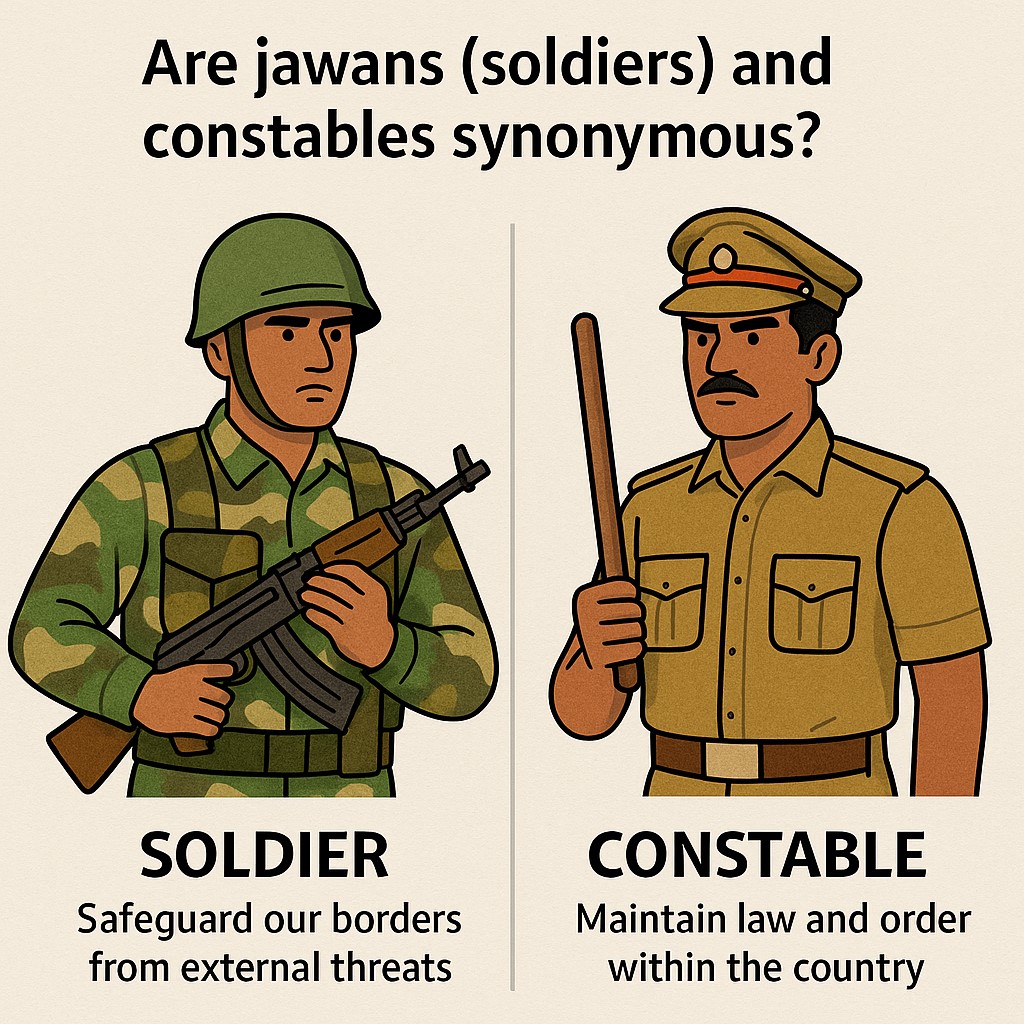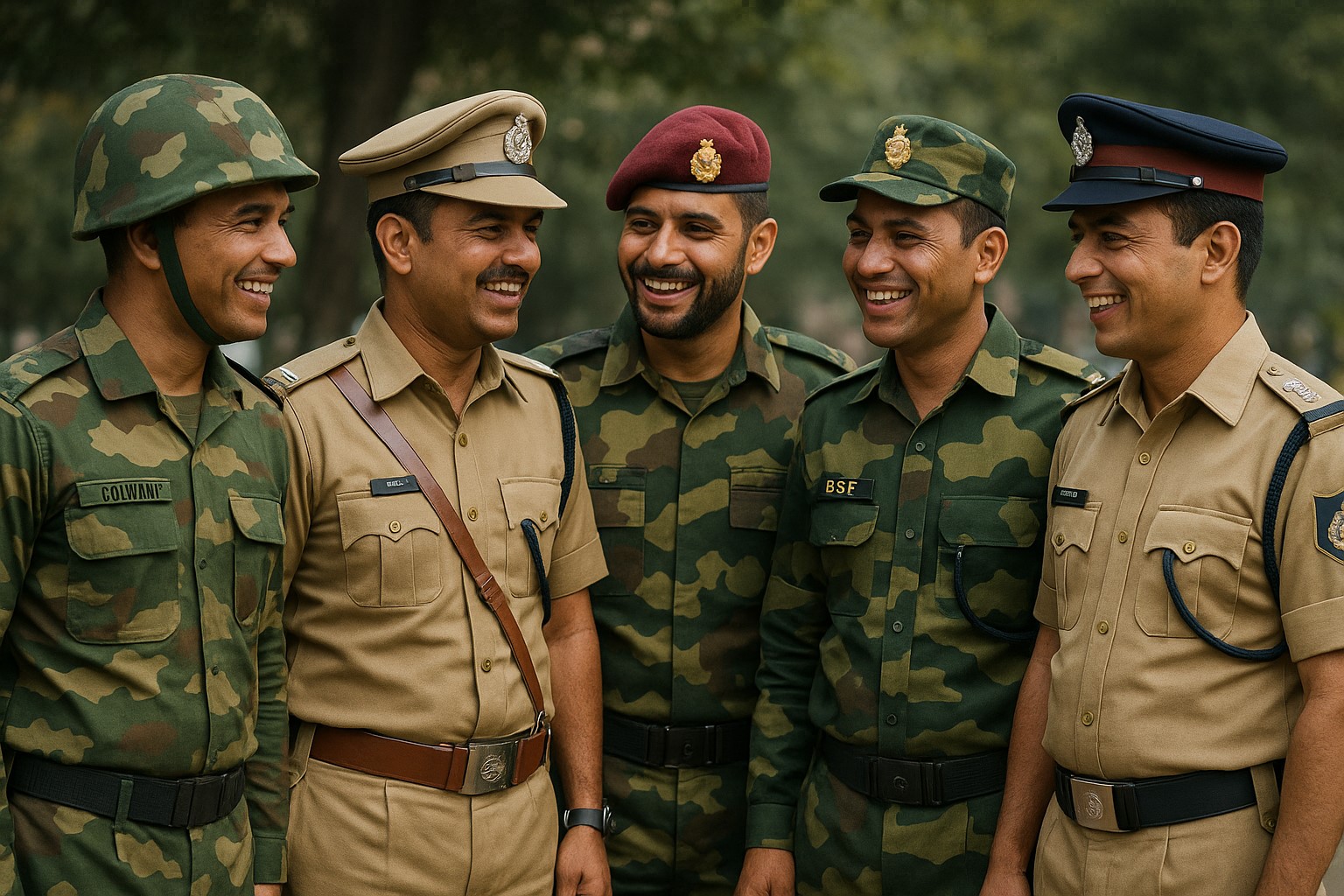Are jawans (soldiers) and constables synonymous? I am sure most of us are aware that the two have different roles assigned by the govt. While a soldier is assigned the primary responsibility to safeguard our borders from external threats, a constable is responsible for maintaining law and order within the country. If that be so, why are these terms being used interchangeably by the media and more pertinent question is that why is this being accepted as fait accompli by the military? Media personnel and the masses could even be excused for their ignorance, as they see a person in combat dress and address him as a soldier, but we the uniformed fraternity ought to know the difference and it is our duty to point that out. My civilian friends may feel that I am unnecessarily being a prude or a stickler, after all both serve the govt and their roles are demanding which require dedication and loyalty of the highest order.

In the last couple of decades, since Indian Army has been actively involved in counter insurgency operations in Jammu & Kashmir as also in the North East, the two agencies have been operating in tandem and at times even in joint operations. This intermingling has blurred the distinction between the two and the end result is this confused state of nomenclature. The Central Armed Police Forces(CAPF), BSF, CRPF, SSB, CISF all are attired in different patterns of combat pattern uniforms. Then there are Assam Rifles and NSG which are even manned/officered by Army personnel. CAPFs are under the Ministry of Home Affairs, whereas Armed Forces fall under the ambit of Ministry of Defence. During the pre-independence period, the uniforms as also the accoutrement of the two were different, the police forces donned Khaki and Army Olive Green. Army was garrisoned and stuck to their cantonments or were in field areas away from the masses, the CAPFs were summoned whenever the situation demanded a beefing up of the police forces, but the Army was only called out when the state govt called out to the Centre to control the state of affairs. Army by its sheer might was equipped to handle any and every such quagmire which the state or central machinery found itself in, and dutifully bailed them out each and every time, restoring the situation and handing it over back to the civil administration.
Army is the last resort which is available with any state, like the panacea, it can handle aid to civil authorities, be it floods, earthquake or natural disasters, insurgency, loot, arson, riots or even rescuing kids stuck in open bore-wells. Now that the distinction between the Army and CAPFs are being blurred deliberately, at last it appears so, we as a nation are at a risk as was witnessed during the riots and arson in Haryana when Gurmeet Ram Rahim was arrested and the Dera followers went on a rampage, where Army units had to carry ‘placards’ that they were Army and not the CAPFs.
This article is not to discredit the CAPFs and the stellar role which they play, but just that the identity and uniqueness of the Military can’t be and should never be under any such ambiguity. While Army has a Sipahi or a soldier, Lance Naik, Naik, Havaldar in the hierarchy of Non Commissioned Officers, the Police forces have a Constable and Head Constable. Then Army has Naib Subedar, Subedar and Subedar Major as Junior Commissioned officers, while the Police forces have Assistant Sub Inspector (ASI), Sub Inspector (SI) and Deputy Superintendent of Police (DSP)/Assistant Superintendent of Police (ASP), who are selected through state level public service commissions or promoted through the constabulary.
If the designations and uniforms are distinct and different, then why should there be this confusion? Isn’t it high time, there are clear diktats issued to safeguard this distinction and identity. We have observed that in the recent past a number of incidents have been reported where the police personnel have behaved in a high headed manner in their dealings with the Defence personnel, even with senior serving personnel. Punjab incident being the most recent one where a serving Colonel along with his son were roughed up by the police personnel. This malaise will progressively worsen if measures are not instituted forthwith to address the situation before it ends up demoralising the last bastion of the nation or worse if they decide to take law into their own hands and mete out exemplary punishment to the perpetrators.


49 thoughts on “Is a Constable a Jawan ?”
Pertinent issue.
This clarity underpins the covenant between the state and its citizens. Clears lanes between the instruments of force for citizens see, feel and understand.
Do you think power that be and people in power don’t know/understand this? This is an old Nevhruvian mindset of all politicians to be wary of armed forces. It is not likely to change in near future. It is understood and felt that armed forces officers are not as pliant as IPS.
Valid points.
2 points that should be implemented. One – Our Civil Militiary Liaison must be exemplary. I am speaking from my experience of various incidents and my last appointment as Station Commander in Kochi. Good Liasion means if any Military person is caught outside for an incident other than Rape, Murder or Culpabke homicide leading to murder – he must be handed over to Military Police. For the Military laws are more stringent, and action surely happens. This understanding must exist with the local police. Here Liaison must be at grassroots level., for incidents happen at grassroots. I suppose I don’t have to elaborate and everybody understands the details in this suggestion.
Second is now becoming increasingly difficult to implement. There must be no copying of uniform, badges of rank, and insignia of the Military by any civil agency including the Police . There are laws on this but it is not implemented citing some obscure differences (much like ambush marketing). It is important for the Public also to discern the difference at sight. Today we even have gate keepers , janitors etc wearing badges of rank, school bands wearing Military peak caps, the spread is disturbing. The term Security Forces is used so casually. An example – foreign media makes comments that Kashmir is under Military rule – for what they see is uniform all round. That uniform should be Khaki not OG. And when OG comes in – that too must be clear.
Public awareness on the why is also Important
Aptly brought out
Suyesh,
Rightly brought out. We saw the state of affairs. All need to understand the difference between OG and Khaki. well said
Thank you Suyash for writing on the important issue.
When the nationalism becomes too jingoistic and everything is seen from one lens this is bound to happen.
The top brass from the forces are so pliable unfortunately and visibly so, then we should not expect anything else.
Replacing age old music like the last post with some Bollywood songs, loudly cheered by the media, the amalgamation of the cantonments and so on would lead to one nation one thought and one forces.
👍
The challenge is real for sure. A bit confused on this myself, but somehow I am not convinced that all the issues raised constitute the cause rather than the symptom. Will the and the diktats recommended solve the concern? I think this calls for greater reflection!
Nicely covered Suyash, thanks for giving the equivalence of Ranks amongst the various services : An important issue well covered. Mutual respect between the arms of the Government is a must- Arun
Relevant issue.
Very well articulated and rightfully brought out by Cmde Anil Joseph that we in the uniform need to be more stringent to take corrective action while handling or coming across such incidents.
While most it covers correct but after SIs , it’s the CI and not the Dy Sp or ASP.. Dy Sp and ASPs are first ranks actually of officers. You may equate them to the newly commissioned YOs Lts of the Army..
Both serve with dedication, but not in the same way, nor under the same conditions. Recognizing this isn’t division – it’s due acknowledgment. A soldier often deployed in harsh and remote terrains under life-threatening conditions, remains for long stretches away from family and is exposed to enemy fire. They also face significant curtailments in fundamental rights, including restrictions on unionizing, freedom of speech, and even legal recourse under ordinary civil law. On the other hand, a constable has much favourable conditions. It is important for media, policymakers, and the public to respect these distinctions.
The police and the CAPF have copied the various attributes of the Army to gain credibility with the masses.
Nicely brought out, Suyash.
The maximum age at which Lance Naiks and Sepoys in the Army retire is 37 years. Hence the term ‘Jawan’. Not so in the Police and CAPFs, who go on at least two more decades.
Look forward to your writing on the misuse of the term Commando – a soldier who operates behind enemy lines – by the Police and CAPFs.
There is definitely a large demarcation between the two, but in the armpit of politicians, the imbalance will automatically set in . It varies from state to state. The normal citizen (aam Janata) see the activities accordingly .
There is definitely a large demarcation between the two, but in the armpit of politicians, the imbalance will automatically set in . It varies from state to state. The normal citizen (aam Janata) see the activities accordingly .
The Babudom was always complexed about the military due to its armaments , lifestyle, pomp and show, glory, battle honours, and of course, the love showered upon them by the masses.
The Babudom discarded the term “Para Military” and replaced it with “CAPF” to signify their uniqueness, but “dressed up” the CAPF as “military like”. Over a period of time, they ensured that police personnel get similar perks and privileges too. Times are changing.
A nice write up Suyash !
The distinction is important. Armed Forces are the last bastion and there is need for the government to always keep it at that pedestal for the good of the nation’s security.
Brig Suyash Sharma’s article highlights a crucial issue regarding the distinction between soldiers and constables. The interchangeable use of these terms can lead to confusion and undermine the unique identities of both roles.
The author rightly points out that while both serve the government, their roles and responsibilities differ significantly. The military’s primary responsibility is to safeguard the country’s borders, whereas constables maintain law and order within the country.
The blurring of lines between the two agencies can have serious consequences, as witnessed during the riots in Haryana. It’s essential to maintain the distinction between the Army and CAPFs to avoid confusion and ensure clarity.
Kudos to the author for shedding light on this important issue. Clear guidelines should be issued to safeguard the distinction and identity of the Military and CAPFs.
Pretty nice post. I just stumbled upon your blog and wished to say that I have truly enjoyed browsing your blog posts. In any case I’ll be subscribing to your feed and I hope you write again very soon!
Hondrolife a Milano a Catania – prodotto
top. Il gonfiore è sparito. Recensioni positive
I was very pleased to find this web-site.I wanted to thanks for your time for this wonderful read!! I definitely enjoying every little bit of it and I have you bookmarked to check out new stuff you blog post.
There is noticeably a bundle to know about this. I assume you made certain nice points in features also.
There are definitely numerous particulars like that to take into consideration. That could be a nice point to bring up. I provide the ideas above as common inspiration however clearly there are questions just like the one you bring up the place a very powerful factor shall be working in honest good faith. I don?t know if greatest practices have emerged around issues like that, however I’m certain that your job is clearly recognized as a good game. Both boys and girls feel the impact of just a moment’s pleasure, for the remainder of their lives.
Промокод на 75 фриспинов — плюс 9к.
игровой клуб Лев
Сорвал джекпот 850 тысяч в слоте Divine
Fortune. До сих пор в шоке.
Лев казино
Вчера зашёл, поставил 500 р на
слот с египетской темой — через 15 минут вывел 42
тысячи. Реально работает, без обмана.
игровой клуб Лев играть
Минимум на вывод — 500 рублей.
Удобно.
казино Эльдорадо
Бонус на выходные 50% — играю по субботам
https://aladin999.co/melbet-bukmekerskaya-kontora-oficial-2025/
Случайно зашёл в краш, поднял 7к за 5 минут
https://aztekhub.com/2025/10/26/obzor-melbet-2025-top-bukmekerskaya-kontora/
Вывод на Bitcoin — без верификации
https://shreejiautomobiles.co.in/melbet-oficialnyy-obzor-2025/
Кэшбэк 10% каждую неделю — реально возвращают, не пустые слова
https://www.walterchasemusic.com/2025/10/19/sait-bk-melbet-obzor-2025/
Выводил 300к частями, всё пришло
https://achutha.com/melbet-games-oficialnyj-sajt-obzor-2025/
Рулетка европейская, преимущество казино минимальное
https://fcioutdoorfurniture.wordpress.com/2025/10/20/promokod-melbet-besplatnaya-stavka-2025/
Играю вечером, после работы — отдых
https://dev.gsmindustrial.cl/melbet-oficialniy-sayt-vhod-v-lichniy-kabinet-2025/
Вывод на Payeer — 2 минуты
https://copierninja.com/index.php/2025/10/16/melbet-2025-obzor-bk/
Техподдержка помогла восстановить пароль за 2 минуты
https://www.fotoproturkiye.com/2025/10/19/melbet-vhod-s-mobilnogo-2025/
Играю с айфона, приложение не жрёт батарею
https://deniz.pk/?p=226568
Верификация по паспорту —
загрузил, через час одобрили
https://hpceducation.in/melbet-bonus-kod-2025/
Выводил 120к на СБП — пришло за
4 минуты
https://anvruonlineservices.co.in/melbet-bonus-kod-2025/
онлайн игры с читами для андроид — это отличный способ изменить
игровой опыт. Особенно если вы пользуетесь устройствами на платформе Android,
модификации открывают перед вами большие перспективы.
Я часто использую взломанные игры, чтобы наслаждаться бесконечными
возможностями.
Моды для игр дают невероятную персонализированный подход,
что погружение в игру гораздо увлекательнее.
Играя с модификациями, я могу повысить уровень сложности, что добавляет новые приключения и делает игру более
достойной внимания.
Это действительно захватывающе, как такие
изменения могут улучшить взаимодействие с
игрой, а при этом не нарушая использовать такие игры с
изменениями можно без особых опасностей,
если быть внимательным и следить за обновлениями.
Это делает каждый игровой процесс персонализированным, а возможности практически
неограниченные.
Советую попробовать такие модифицированные версии для
Android — это может придаст новый смысл
Найти нужный раздел или автомат не
составит труда, вся навигация разбита
на категории и разделы сайта.
жду подборку инструментов контроля качества
https://181cargo.ru/
Перестал сидеть целыми днями и стало легче дышать
https://storeprofit.ru/
темы очень структурированные — лайк!
https://доставка-карго-из-китая.рф/
карго кажется сложным, но тут всё по делу
https://777cargo.ru/